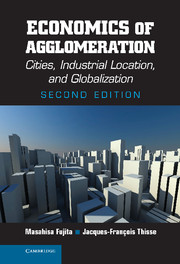Book contents
- Frontmatter
- Dedication
- Contents
- Acknowledgments
- Preface to the Second Edition
- 1 Agglomeration and Economic Theory
- Part I Fundamentals of Spatial Economics
- Part II The Structure of Metropolitan Areas
- Part III Factor Mobility and Industrial Location
- Part IV Urban Systems, Regional Growth, and the Multinationalization of Firms
- 10 Back to von Thünen: The Emergence of Cities in a Spatial Economy
- 11 Globalization, Growth, and the Geography of the Supply Chain
- References
- Author Index
- Subject Index
11 - Globalization, Growth, and the Geography of the Supply Chain
Published online by Cambridge University Press: 05 August 2013
- Frontmatter
- Dedication
- Contents
- Acknowledgments
- Preface to the Second Edition
- 1 Agglomeration and Economic Theory
- Part I Fundamentals of Spatial Economics
- Part II The Structure of Metropolitan Areas
- Part III Factor Mobility and Industrial Location
- Part IV Urban Systems, Regional Growth, and the Multinationalization of Firms
- 10 Back to von Thünen: The Emergence of Cities in a Spatial Economy
- 11 Globalization, Growth, and the Geography of the Supply Chain
- References
- Author Index
- Subject Index
Summary
INTRODUCTION
Globalization is a multifaceted process. This chapter aims to address two of them that we consider as central for the future of our economies. Firstly, we build on the idea that knowledge spillovers are an important channel in the spatial diffusion of technological progress. Our goal is to understand how these spillovers affect the growth of various regions, especially through their spatial extent. Secondly, it is recognized that the contemporary and spectacular decrease in communication costs deeply affects the organization of firms through the spatial fragmentation of the supply chain. This in turn has a knock-on effect on the way the space-economy is organized. The common thread of this chapter therefore is to find out how the transfer of knowledge and information across space affects the location of economic activity. Note a major difference between spillover and communication: in the former, the information learned from others is the involuntary consequence of activities undertaken by some agents; in the latter, communication costs arise because geographically separated agents choose to exchange information.
As seen in Chapter 8, market integration might well be accompanied by the appearance of some core regions whose wealth is, in part, obtained at the expense of peripheral regions: the average welfare in the region accommodating the manufacturing sector rises but it decreases in the other. So far, however, such a result has been obtained in the context of static models in which the total number of firms and varieties is constant.
- Type
- Chapter
- Information
- Economics of AgglomerationCities, Industrial Location, and Globalization, pp. 426 - 472Publisher: Cambridge University PressPrint publication year: 2013



